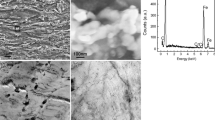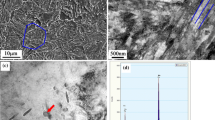Abstract
The carbon dioxide corrosion behavior of low alloy pipeline steel was investigated by immersion experiment. Optical microscopy (OM), scanning electron microscopy (SEM), transmission electron microscopy (TEM), and X-ray diffraction (XRD) were used to reflect the microstructure of the tested material and the corrosion morphology characterization. Results show that precipitate particles may accelerate the iron cabonate crystal formation process of the nucleation growth and promote the formation of compact layer. The major corrosion phases are FeCO3 and complexity compound containing Fe and Cr. The corrosion behavior consists of three stages. At the first stage, a thin inner layer and an inhomogeneous outer layer have appeared. At the second stage, the outer layer becomes homogeneous and compact, which prevents corroding the steel substrate further. At the third stage, iron carbonate crystal tends to nucleate and grow locally. The corrosion rate obtained by weight loss method increases abruptly first and then decreases quickly with increasing corrosion time. The mutual relation among microstructure, corrosion surface morphology, corrosion phases and corrosion kinetics is discussed.
Similar content being viewed by others
References
Zhang J, Wang ZL, Wang ZM, et al. Chemical Analysis of the Initial Corrosion Layer on Pipeline Steels in Simulated CO2-Enhanced Oil Recovery Brines[J]. Corrosion Science, 2012, 65: 397–404
Lin NM, Xie FQ, Zhao J, et al. Corrosion Behavior of P110 Steel and Chromiun Coating in CO2-simulated Oilfield Brine[J]. Journal of Wuhan University of Technology-Materials Science Edition, 2011, 26(2): 191–197
Li WF, Zhao YJ, Xue Y. Corrosion Behavior about Tubing Steel in Environment with High H2S and CO2 Content[J]. Journal of Wuhan University of Technology -Materials Science Edition, 2013, 28(5): 1038–1043
Faysal FE, Farzad M, Akram A. An Electrochemical Investigation on the Effect of the Chloride Content on CO2 Corrosion of API-X100 Steel[J]. Corrosion Science, 2012, 64: 37–43
Xie Y, Xu LN, Gao CL, et al. Corrosion Behavior of Novel 3% Cr Pipeline Steel in CO2 Top-of-Line Corrosion Environment[J]. Materials and Design, 2012, 36: 54–57
Guo SQ, Xu LN, Zhang L, et al. Corrosion of Alloy Steels Containing 2% Chromiun in CO2 Environments[J]. Corrosion Science, 2012, 63: 246–258
Carvalho DS, Joia CJB, Mattos OR. Corrosion Rate of Iron and Ironchromium Alloys in CO2 Medium[J]. Corrosion Science, 2005, 47: 2974–2986
Gao KW, Yu F, Pang XL, et al. Mechanical Properties of CO2 Corrosion Product Scales and Their Relationship to Corrosion Rate[J]. Corrosion Science, 2008, 50: 2796–2803
Yu F, Gao KW, Su YJ, et al. The Fracture Toughness of CO2 Corrosion Scale in Pipeline Steel[J]. Materials Letters, 2005, 59: 1709–1713
Zhang Z, Li CJ, Zhang JY, et al. Corrosion Rate of Hydrogenation to C110 Casing in High H2S Environment[J]. Journal of Wuhan University of Technology -Materials Science Edition, 2012, 27(6): 1080–1083
Pfennig A, Kranzmann A. Effect of CO2 and Pressure on the Stability of Steels with Different Amounts of Chromium in Saline Water[J]. Corrosion Science, 2012, 65: 441–452
Pfennig A, Zastrow P, Kranzmann A. Influence of Heat Treatment on the Corrosion Behaviour of Stainless Steels during CO2-sequestration into Saline Aquifer[J]. International Journal of Greenhouse Gas Control, 2013, 15: 213–224
Pfennig A, Kranzmann A. Reliability of Pipe Steels with Different Amounts of C and Cr during onshore Carbon Dioxide Injection[J]. International Journal of Greenhouse Gas Control, 2011, 5: 757–769
Ingham B, Ko M, Kear G, et al. In situ Synchrotron X-ray Different Study of Surface Scale Formation during CO2 Corrosion of Carbon Steel at Temperature up to 90 ?[J]. Corrosion Science, 2010, 52: 3052–3061
Ko M, Ingham B, Laycock N, et al. In situ Synchrotron X-ray Different Study of the Effect of Chromium Additions to the Steel and Solution on CO2 Corrosion of Pipeline Steels[J]. Corrosion Science, 2014, 80: 237–246
Nazari MH, Allahkaram SR, Kermani MB. The Effects of Temperature and pH on the Characteristics of Corrosion Product in CO2 Corrosion of Grade X70 Steel[J]. Materials and Design, 2010, 31: 3559–3563
Choi YS, Nešic S. Determining the Corrosive Potential of CO2 Transport Pipeline in High pCO2-water Environment[J]. International Journal of Greenhouse Gas Control, 2011, 5: 788–797
Cui ZD, Wu SL, Zhu SL, et al. Study on Corrosion Properties of Pipelines in Simulated Produced Water Saturated with Supercritical CO2[J]. Applied Surface Science, 2006, 252: 2368–2374
Wu QL, Zhang ZH, Dong XM, et al. Corrosion Behavior of Low-alloy Steel Containing 1% Chromium in CO2 Environments[J]. Corrosion Science, 2013, 75: 400–408
Paolinelli LD, Pérez T, Simison SN. The Effect of Pre-corrosion and Steel Microstructure on Inhibitor Performance in CO2 Corrosion[J]. Corrosion Science, 2008, 50: 2456–2464
Sun JB, Zhang GA, Liu W, et al. The Formation Mechanism of Corrosion Scale and Electrode Characteristic of Low Alloy Steel in Carbon Dioxide–Saturated Solution[J]. Corrosion Science, 2012, 57: 131–138
López DA, Schreiner WH, Sánchez SR, et al. The Influence of Carbon Steel Microstructure on Corrosion Layers: An XPS and SEM Characterization[J]. Applied Surface Science, 2003, 207: 69–85
López DA, Pérez T, Simison SN. The Influence of Microstructure and Chemical Composition of Carbon and Low Alloy Steels in CO2 Corrosion: A State-of-the art Appraisal[J]. Materials and Design, 2003, 24: 561–575
López DA, Simison SN, Sánchez SR. The Influence of Steel Microstructure on CO2 Corrosion: EIS Studies on the Inhibition Efficiency of Benzimidazole[J]. Electrochimica Acta, 2003, 48: 845–854
Zhang YC, Pang XL, Qu SP, et al. Discussion of the CO2 Corrosion Mechanism between Low Partial Pressure and Supercritical Condition[J]. Corrosion Science, 2012, 59: 186–197
Gao M, Pang X, GAO K. The Growth Mechanism of CO2 Corrosion Product Films[J]. Corrosion Science, 2011, 53: 557–568
Author information
Authors and Affiliations
Corresponding author
Additional information
Supported by National Key Technology Research and Development Program of the Ministry of Science and Technology of China during the “12th Five-Year Plan”(No. 2011BAE25B03), National High Technology Research and Development Program of China (No.2015AA03A501) and the National Natural Science Foundation of China (No. 51274063)
Rights and permissions
About this article
Cite this article
Liu, Z., Gao, X., Li, J. et al. Corrosion behavior of low alloy pipeline steel in saline solution saturated with supercritical carbon dioxide. J. Wuhan Univ. Technol.-Mat. Sci. Edit. 31, 654–661 (2016). https://doi.org/10.1007/s11595-016-1425-5
Received:
Accepted:
Published:
Issue Date:
DOI: https://doi.org/10.1007/s11595-016-1425-5




